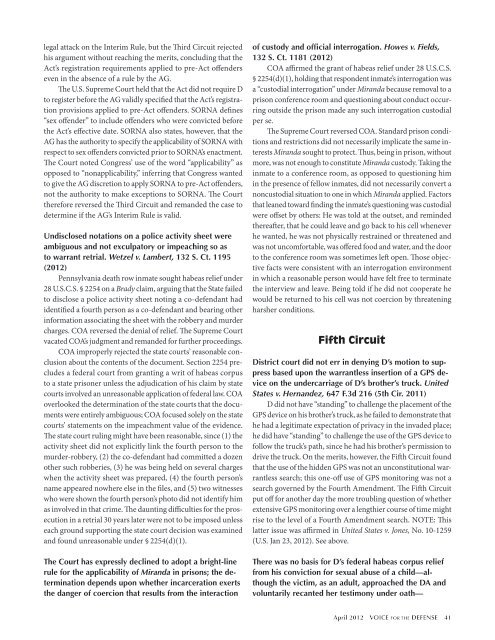for the defense for the defense - Voice For The Defense Online
for the defense for the defense - Voice For The Defense Online
for the defense for the defense - Voice For The Defense Online
You also want an ePaper? Increase the reach of your titles
YUMPU automatically turns print PDFs into web optimized ePapers that Google loves.
legal attack on <strong>the</strong> Interim Rule, but <strong>the</strong> Third Circuit rejectedhis argument without reaching <strong>the</strong> merits, concluding that <strong>the</strong>Act’s registration requirements applied to pre-Act offenderseven in <strong>the</strong> absence of a rule by <strong>the</strong> AG.<strong>The</strong> U.S. Supreme Court held that <strong>the</strong> Act did not require Dto register be<strong>for</strong>e <strong>the</strong> AG validly specified that <strong>the</strong> Act’s registrationprovisions applied to pre-Act offenders. SORNA defines“sex offender” to include offenders who were convicted be<strong>for</strong>e<strong>the</strong> Act’s effective date. SORNA also states, however, that <strong>the</strong>AG has <strong>the</strong> authority to specify <strong>the</strong> applicability of SORNA withrespect to sex offenders convicted prior to SORNA’s enactment.<strong>The</strong> Court noted Congress’ use of <strong>the</strong> word “applicability” asopposed to “nonapplicability,” inferring that Congress wantedto give <strong>the</strong> AG discretion to apply SORNA to pre-Act offenders,not <strong>the</strong> authority to make exceptions to SORNA. <strong>The</strong> Court<strong>the</strong>re<strong>for</strong>e reversed <strong>the</strong> Third Circuit and remanded <strong>the</strong> case todetermine if <strong>the</strong> AG’s Interim Rule is valid.Undisclosed notations on a police activity sheet wereambiguous and not exculpatory or impeaching so asto warrant retrial. Wetzel v. Lambert, 132 S. Ct. 1195(2012)Pennsylvania death row inmate sought habeas relief under28 U.S.C.S. § 2254 on a Brady claim, arguing that <strong>the</strong> State failedto disclose a police activity sheet noting a co-defendant hadidentified a fourth person as a co-defendant and bearing o<strong>the</strong>rin<strong>for</strong>mation associating <strong>the</strong> sheet with <strong>the</strong> robbery and murdercharges. COA reversed <strong>the</strong> denial of relief. <strong>The</strong> Supreme Courtvacated COA’s judgment and remanded <strong>for</strong> fur<strong>the</strong>r proceedings.COA improperly rejected <strong>the</strong> state courts’ reasonable conclusion about <strong>the</strong> contents of <strong>the</strong> document. Section 2254 precludesa federal court from granting a writ of habeas corpusto a state prisoner unless <strong>the</strong> adjudication of his claim by statecourts involved an unreasonable application of federal law. COAoverlooked <strong>the</strong> determination of <strong>the</strong> state courts that <strong>the</strong> documentswere entirely ambiguous; COA focused solely on <strong>the</strong> statecourts’ statements on <strong>the</strong> impeachment value of <strong>the</strong> evidence.<strong>The</strong> state court ruling might have been reasonable, since (1) <strong>the</strong>activity sheet did not explicitly link <strong>the</strong> fourth person to <strong>the</strong>murder-robbery, (2) <strong>the</strong> co-defendant had committed a dozeno<strong>the</strong>r such robberies, (3) he was being held on several chargeswhen <strong>the</strong> activity sheet was prepared, (4) <strong>the</strong> fourth person’sname appeared nowhere else in <strong>the</strong> files, and (5) two witnesseswho were shown <strong>the</strong> fourth person’s photo did not identify himas involved in that crime. <strong>The</strong> daunting difficulties <strong>for</strong> <strong>the</strong> prosecutionin a retrial 30 years later were not to be imposed unlesseach ground supporting <strong>the</strong> state court decision was examinedand found unreasonable under § 2254(d)(1).<strong>The</strong> Court has expressly declined to adopt a bright-linerule <strong>for</strong> <strong>the</strong> applicability of Miranda in prisons; <strong>the</strong> determinationdepends upon whe<strong>the</strong>r incarceration exerts<strong>the</strong> danger of coercion that results from <strong>the</strong> interactionof custody and official interrogation. Howes v. Fields,132 S. Ct. 1181 (2012)COA affirmed <strong>the</strong> grant of habeas relief under 28 U.S.C.S.§ 2254(d)(1), holding that respondent inmate’s interrogation wasa “custodial interrogation” under Miranda because removal to aprison conference room and questioning about conduct occurringoutside <strong>the</strong> prison made any such interrogation custodialper se.<strong>The</strong> Supreme Court reversed COA. Standard prison conditionsand restrictions did not necessarily implicate <strong>the</strong> same interestsMiranda sought to protect. Thus, being in prison, withoutmore, was not enough to constitute Miranda custody. Taking <strong>the</strong>inmate to a conference room, as opposed to questioning himin <strong>the</strong> presence of fellow inmates, did not necessarily convert anoncustodial situation to one in which Miranda applied. Factorsthat leaned toward finding <strong>the</strong> inmate’s questioning was custodialwere offset by o<strong>the</strong>rs: He was told at <strong>the</strong> outset, and reminded<strong>the</strong>reafter, that he could leave and go back to his cell wheneverhe wanted, he was not physically restrained or threatened andwas not uncom<strong>for</strong>table, was offered food and water, and <strong>the</strong> doorto <strong>the</strong> conference room was sometimes left open. Those objectivefacts were consistent with an interrogation environmentin which a reasonable person would have felt free to terminate<strong>the</strong> interview and leave. Being told if he did not cooperate hewould be returned to his cell was not coercion by threateningharsher conditions.Fifth CircuitDistrict court did not err in denying D’s motion to suppressbased upon <strong>the</strong> warrantless insertion of a GPS deviceon <strong>the</strong> undercarriage of D’s bro<strong>the</strong>r’s truck. UnitedStates v. Hernandez, 647 F.3d 216 (5th Cir. 2011)D did not have “standing” to challenge <strong>the</strong> placement of <strong>the</strong>GPS device on his bro<strong>the</strong>r’s truck, as he failed to demonstrate tha<strong>the</strong> had a legitimate expectation of privacy in <strong>the</strong> invaded place;he did have “standing” to challenge <strong>the</strong> use of <strong>the</strong> GPS device tofollow <strong>the</strong> truck’s path, since he had his bro<strong>the</strong>r’s permission todrive <strong>the</strong> truck. On <strong>the</strong> merits, however, <strong>the</strong> Fifth Circuit foundthat <strong>the</strong> use of <strong>the</strong> hidden GPS was not an unconstitutional warrantlesssearch; this one-off use of GPS monitoring was not asearch governed by <strong>the</strong> Fourth Amendment. <strong>The</strong> Fifth Circuitput off <strong>for</strong> ano<strong>the</strong>r day <strong>the</strong> more troubling question of whe<strong>the</strong>rextensive GPS monitoring over a lengthier course of time mightrise to <strong>the</strong> level of a Fourth Amendment search. NOTE: Thislatter issue was affirmed in United States v. Jones, No. 10-1259(U.S. Jan 23, 2012). See above.<strong>The</strong>re was no basis <strong>for</strong> D’s federal habeas corpus relieffrom his conviction <strong>for</strong> sexual abuse of a child—although<strong>the</strong> victim, as an adult, approached <strong>the</strong> DA andvoluntarily recanted her testimony under oath—
















